Longitudinal River Monitoring and Modelling Substantiate the Impact of Weirs on Nitrogen Dynamics
Abstract
:1. Introduction
2. Materials and Methods
2.1. Study Area
2.2. Model Description
2.3. Data Collection and Preparation
2.4. Nitrogen Modelling and Calibration with HEC-RAS-NSM-I
2.5. Evaluation of Model Calibration Performance
2.6. Sensitivity Analysis of Spatial Discretization with HEC-RAS-NSM-I
2.7. Quantification of River Denitrification Dynamics
3. Results and Discussion
3.1. Hydrodynamic Model Calibration Using High-Resolution Flow Data
3.2. Eulerian Calibration with HEC-RAS-NSM-I Model
3.3. Lagrangian Calibration with HEC-RAS-NSM-I Model
3.4. Spatial Model Discretization as Constraint for Uncertainty Assessment
3.5. Quantification of River Denitrification Dynamics
3.6. Methodical Limitations and Future Research
4. Conclusions
Author Contributions
Funding
Institutional Review Board Statement
Informed Consent Statement
Data Availability Statement
Acknowledgments
Conflicts of Interest
Appendix A
| Parameter | Unit | Source |
|---|---|---|
| Geometry of river cross sections and weirs | - | State Dam Administration of Saxony |
| Digital terrain model | grid size 2 × 2 m | GeoSN (State Office for Geospatial Information and Surveying of Saxony) |
| Flow discharge | m3 s−1 | Water gauge network [49], WWTP operation booklets Water gauge network [49] |
| Water stage | m | |
| Global radiation | W m−2 | Climate station network [42] |
| Air temperature | °C | |
| Air humidity | % | |
| Air wind velocity | m s−1 | |
| Dissolved nitrate nitrogen (NO3-N) | mg L−1 | Water quality monitoring stations (WQMST) [49], WWTP operation booklets, Longitudinal boat-based sampling |
| Dissolved nitrite nitrogen (NO2-N) 1 | mg L−1 | |
| Dissolved ammonium nitrogen (NH4-N) 1 | mg L−1 | |
| Dissolved organic nitrogen (Org-N) 1 | mg L−1 | |
| Total organic carbon (TOC) | mg L−1 | |
| Dissolved organic carbon (DOC) | mg L−1 | |
| Dissolved oxygen (DO) | mg L−1 | |
| Water temperature | °C | |
| Phytoplankton algae (algae) 2 | mg L−1 | |
| Carbonaceous biochemical | ||
| oxygen demand (CBOD) 2 | mg L−1 | |
| pH | - |
References
- Carvalho, L.; Mackay, E.B.; Cardoso, A.C.; Baattrup-Pedersen, A.; Birk, S.; Blackstock, K.L.; Borics, G.; Borja, A.; Feld, C.K.; Ferreira, M.T.; et al. Protecting and restoring Europe’s waters: An analysis of the future development needs of the Water Framework Directive. Sci. Total Environ. 2019, 658, 1228–1238. [Google Scholar] [CrossRef] [PubMed]
- Kristensen, P.; Whalley, C.; Zal, F.N.N.; Christiansen, T. European Waters Assessment of Status and Pressures 2018; EEA Report (7/2018); European Environment Agency: Copenhagen, Denmark, 2018. Available online: https://www.eea.europa.eu/publications/state-of-water (accessed on 2 July 2021).
- Birk, S.; Bonne, W.; Borja, A.; Brucet, S.; Corral, A.; Poikane, S.; Solimini, A.; van de Bund, W.; Zampoukas, N.; Hering, D. Three hundred ways to assess Europe’s surface waters: An almost complete overview of biological methods to implement the Water Framework Directive. Ecol. Indic. 2012, 18, 31–41. [Google Scholar] [CrossRef]
- Kristensen, P.; Solheim, A.; Austnes, K. The water framework directive and state of Europe’s water. Eur. Water 2013, 44, 3–10. [Google Scholar]
- Schepers, J.S.; Varvel, G.E.; Watts, D.G. Nitrogen and water management strategies to reduce nitrate leaching under irrigated maize. J. Contam. Hydrol. 1995, 20, 227–239. [Google Scholar] [CrossRef]
- He, B.; Kanae, S.; Oki, T.; Hirabayashi, Y.; Yamashiki, Y.; Takara, K. Assessment of global nitrogen pollution in rivers using an integrated biogeochemical modeling framework. Water Res. 2011, 45, 2573–2586. [Google Scholar] [CrossRef] [PubMed]
- Gruber, N.; Galloway, J.N. An earth-system perspective of the global nitrogen cycle. Nature 2008, 451, 293–296. [Google Scholar] [CrossRef] [PubMed]
- Davis, J.R.; Koop, K. Eutrophication in Australian rivers, reservoirs and estuaries e a southern hemisphere perspective on the science and its implications. Hydrobiologia 2006, 559, 23–76. [Google Scholar] [CrossRef]
- Chapra, S.C. Surface Water-Quality Modeling; Waveland Press: Long Grove, IL, USA, 2008; pp. 419–430. [Google Scholar]
- Palmer, M.D. Water Quality Modeling: A Guide to Effective Practice; The World Bank: Washington, DC, USA, 2001; Available online: https://elibrary.worldbank.org/doi/abs/10.1596/0-8213-4863-9 (accessed on 30 June 2021).
- Grizzetti, B.; Passy, P.; Billen, G.; Bouraoui, F.; Garnier, J.; Lassaletta, L. The role of water nitrogen retention in integrated nutrient management: Assessment in a large basin using different modelling approaches. Environ. Res. Lett. 2015, 10, 065008. [Google Scholar] [CrossRef]
- Mei, K.; Zhu, Y.; Liao, L.; Dahlgren, R.; Shang, X.; Zhang, M. Optimizing water quality monitoring networks using continuous longitudinal monitoring data: A case study of Wen-Rui Tang River, China. J. Environ. Monitor. 2011, 13, 2755–2762. [Google Scholar] [CrossRef]
- Volkmar, E.C.; Dahlgren, R.A.; Stringfellow, W.T.; Henson, S.S.; Borglin, S.E.; Kendall, C.; Van Nieuwenhuyse, E.E. Using Lagrangian sampling to study water quality during downstream transport in the San Luis Drain, California, USA. Chem. Geol. 2011, 283, 68–77. [Google Scholar] [CrossRef]
- Whitehead, P.G.; Williams, R.J. A dynamic nitrogen balance model for river systems. In Proceedings of the Exeter Symposium, Exeter, UK, 19–30 July 1982; pp. 89–99. Available online: http://hydrologie.org/redbooks/a139/iahs_139_0089.pdf (accessed on 30 June 2021).
- Boyer, E.W.; Alexander, R.B.; Parton, W.J.; Li, C.; Butterbach-Bahl, K.; Donner, S.D.; Skaggs, R.W.; Grosso, S.J. Modeling denitrification in terrestrial and aquatic ecosystems at regional scales. Ecol. Appl. 2006, 16, 2123–2142. [Google Scholar] [CrossRef]
- Seitzinger, S.; Harrison, J.A.; Böhlke, J.K.; Bouwman, A.F.; Lowrance, R.; Peterson, B.; Tobias, C.; Drecht, G.V. Denitrification across landscapes and waterscapes: A synthesis. Ecol. Appl. 2006, 16, 2064–2090. [Google Scholar] [CrossRef] [Green Version]
- Brunner, G.W. HEC-RAS River Analysis System, User’s Manual, Version 5.0; U.S. Army Corps of Engineers, Institute for Water Resources, Hydrologic Engineering Center: Davis, CA, USA, 2016. Available online: https://www.hec.usace.army.mil/software/hec-ras/documentation/HEC-RAS%205.0%20Users%20Manual.pdf (accessed on 30 June 2021).
- Zhang, Z.; Johnson, B.E. Application and Evaluation of the HEC-RAS-Nutrient Simulation Module (NSM-I); U.S. Army Engineer Research and Development Center (ERDC): Vicksburg, MS, USA, 2014; Available online: https://usace.contentdm.oclc.org/digital/collection/p266001coll1/id/3855/ (accessed on 30 June 2021).
- Billen, G.; Garnier, J. Nitrogen transfers through the Seine drainage network: A budget based on the application of the Riverstrahler model. Hydrobiologia 1999, 410, 139–150. [Google Scholar] [CrossRef]
- Wagenschein, D.; Rode, M. Modelling the impact of river morphology on nitrogen retention—a case study of the Weisse Elster River (Germany). Ecol. Model. 2008, 211, 224–232. [Google Scholar] [CrossRef]
- Zhang, Z.; Johnson, B.E. Aquatic Nutrient Simulation Modules (NSMs)–Developed for Hydrologic and Hydraulic Models; U.S. Army Engineer Research and Development Center (ERDC): Vicksburg, MS, USA, 2016; Available online: https://erdc-library.erdc.dren.mil/jspui/bitstream/11681/10112/1/ERDC-EL-TR-16-1.pdf (accessed on 30 June 2021).
- Hoang, L.; van Griensven, A.; Mynett, A. Enhancing the SWAT model for simulating denitrification in riparian zones at the river basin scale. Environ. Modell. Softw. 2017, 93, 163–179. [Google Scholar] [CrossRef]
- Seitzinger, S.P.; Styles, R.V.; Boyer, E.W.; Alexander, R.B.; Billen, G.; Howarth, R.W.; Mayer, B.; Van Breemen, N. Nitrogen retention in rivers: Model development and application to watersheds in the northeastern USA. Biogeochemistry 2002, 57, 199–237. [Google Scholar] [CrossRef]
- Cisowska, I.; Hutchins, M.G. The effect of weirs on nutrient concentrations. Sci. Total Environ. 2016, 542, 997–1003. [Google Scholar] [CrossRef] [PubMed] [Green Version]
- Fehér, J.; Gáspár, J.; Szurdiné Veres, K.; Kiss, A.; Austnes, K.; Globevnik, L.; Kirn, T.; Peterlin, M.; Spiteri, C.; Prins, T.; et al. Hydromorphological Alterations and Pressures in European Rivers, Lakes, Transitional and Coastal Waters; European Topic Centre on Inland, Coastal and Marine Waters (ETC/ICM): Prague, Czech Republic, 2012; Available online: https://www.ecologic.eu/11663 (accessed on 30 June 2021).
- De Leaniz, C.G. Weir removal in salmonid streams: Implications, challenges and practicalities. Hydrobiologia 2008, 609, 83–96. [Google Scholar] [CrossRef]
- Harris, J.H.; Kingsford, R.T.; Peirson, W.; Baumgartner, L.J. Mitigating the effects of barriers to freshwater fish migrations: The Australian experience. Mar. Freshw. Res. 2017, 68, 614–628. [Google Scholar] [CrossRef]
- Caraco, N.F.; Cole, J.J. Human impact on nitrate export: An analysis using major world rivers. Ambio 1999, 28, 167–170. [Google Scholar]
- Stanley, E.H.; Doyle, M.W. A geomorphic perspective on nutrient retention following dam removal: Geomorphic models provide a means of predicting ecosystem responses to dam removal. BioScience 2002, 52, 693–701. [Google Scholar] [CrossRef] [Green Version]
- Rathod, P.; Manekar, V.L. Parameter uncertainty in HEC-RAS 1D CSU scour model. Curr. Sci. 2020, 118, 1227. [Google Scholar] [CrossRef]
- Pappenberger, F.; Beven, K.; Horritt, M.; Blazkova, S.J.J.O.H. Uncertainty in the calibration of effective roughness parameters in HEC-RAS using inundation and downstream level observations. J. Hydrol. 2005, 302, 46–69. [Google Scholar] [CrossRef]
- Greif, A. The impact of mining activities in the Ore Mountains on the Mulde river catchment upstream of the Mulde reservoir lake. Hydrol. Wasserbewirtsch. 2015, 59, 318–331. [Google Scholar]
- Spänhoff, B.; Friese, H.; Börke, P.; Kuhn, K.; Pilchowski, D.; Fischer, K. Beiträge zu den Maßnahmenprogrammen der Flussgebietseinheiten Elbe und Oder; Sächsisches Landesamt für Umwelt, Landwirtschaft und Geologie: Dresden, Germany, 2009; Available online: https://publikationen.sachsen.de/bdb/artikel/13810 (accessed on 30 June 2021).
- Küchler, L.; Harnapp, S. Gewässergütebericht 2003–Biologische Befunde der Gewässergüte Sächsischer Fließgewässer mit Gewässergütekarte; Sächsisches Landesamt für Umwelt, Landwirtschaft und Geologie: Dresden, Germany, 2003; Available online: https://publikationen.sachsen.de/bdb/artikel/13633 (accessed on 30 June 2021).
- Gebel, M.; Halbfaß, S.; Bürger, S.; Lorz, C. Long-term simulation of effects of energy crop cultivation on nitrogen leaching and surface water quality in Saxony/Germany. Reg. Environ. Change 2013, 13, 249–261. [Google Scholar] [CrossRef]
- Gebel, M.; Bürger, S.; Halbfaß, S.; Uhlig, M. Nährstoffeinträge in Sächsische Gewässer–Status quo und Ausblick bis 2027; Sächsisches Landesamt für Umwelt, Landwirtschaft und Geologie: Dresden, Germany, 2016; Available online: https://publikationen.sachsen.de/bdb/artikel/11373 (accessed on 30 June 2021).
- Klemm, W.; Greif, A.; Broekaert, J.A.C.; Siemens, V.; Junge, F.W.; van der Veen, A.; Schultze, M.; Duffek, A. A Study on Arsenic and the Heavy Metals in the Mulde River System. Acta Hydrochim. Hydrobiol. 2005, 33, 475–491. [Google Scholar] [CrossRef]
- Knittel, U.; Klemm, W.; Greif, A. Heavy metal pollution downstream of old mining camps as a result of flood events: An example from the Mulde River System, eastern part of Germany. Terr. Atmos. Ocean Sci. 2005, 16, 919–931. [Google Scholar] [CrossRef] [Green Version]
- Greif, A.; Klemm, W. Geogene Hintergrundbelastungen; Sächsisches Landesamt für Umwelt, Landwirtschaft und Geologie: Dresden, Germany, 2010; Available online: https://publikationen.sachsen.de/bdb/artikel/14924 (accessed on 30 June 2021).
- Statistisches Landesamt des Freistaates Sachsen. Bevölkerungsstand, Einwohnerzahlen, Eckdaten für Sachsen. Available online: https://www.statistik.sachsen.de/html/bevoelkerungsstand-einwohner.html (accessed on 30 June 2021).
- Sächsisches Staatsministerium für Energie, Klimaschutz, Umwelt und Landwirtschaft. Lagebericht 2016 zur Beseitigung von Kommunalem Abwasser und Klärschlamm im Freistaat Sachsen; Sächsisches Staatsministerium für Energie, Klimaschutz, Umwelt und Landwirtschaft: Dresden, Germany, 2017; Available online: https://publikationen.sachsen.de/bdb/artikel/28493 (accessed on 30 June 2021).
- Sächsisches Landesamt für Umwelt, Landwirtschaft und Geologie. Agrarmeteorologisches Messnetz Sachsen-Wetterdaten. Available online: https://www.landwirtschaft.sachsen.de/Wetter09/asp/inhalt.asp?seite=uebersicht (accessed on 30 June 2021).
- Sächsisches Landesamt für Umwelt, Landwirtschaft und Geologie. Aktuelle Wasserstände–Leisnig/Freiberger Mulde. Available online: https://www.umwelt.sachsen.de/umwelt/infosysteme/hwims/portal/web/wasserstand-pegel-566085 (accessed on 30 June 2021).
- Sächsisches Staatsministerium für Energie, Klimaschutz, Umwelt und Landwirtschaft. Querbauwerke in Sächsischen Fließgewässern. Available online: https://www.smul.sachsen.de/Wehre/Index.aspx (accessed on 30 June 2021).
- Wiek, S.; Helm, B.; Karrasch, P.; Hunger, S.; Hoffmann, T.G.; Schoenrock, S.; Klehr, W.; Six, A.; Staeglich, I.; Kuhn, K.; et al. Boat-based measurement system for longitudinal monitoring of rivers with online sensors. Hydrol. Wasserbewirtsch. 2019, 63, 19–32. [Google Scholar]
- Brunner, G.W. HEC-RAS River Analysis System, Hydraulic Reference Manual, Version 5.0; U.S. Army Corps of Engineers, Hydrologic Engineering Center: Davis, CA, USA, 2016. Available online: https://www.hec.usace.army.mil/software/hec-ras/documentation/HEC-RAS%205.0%20Reference%20Manual.pdf (accessed on 30 June 2021).
- Leonard, B.P. The ULTIMATE conservative difference scheme applied to unsteady one-dimensional advection. Comput. Methods Appl. Mech. Eng. 1991, 88, 17–74. [Google Scholar] [CrossRef]
- US Army Corps of Engineers, Institute for Water Resources, Hydrologic Engineering Center. HEC-DSSVue, HEC Data Storage System Visual Utility Engine, User’s Manual; US Army Corps of Engineers, Institute for Water Resources: Davis, CA, USA, 2009; Available online: https://www.hec.usace.army.mil/software/hec-dss/documentation/HEC-DSSVue_20_Users_Manual.pdf (accessed on 30 June 2021).
- Sächsisches Landesamt für Umwelt, Landwirtschaft und Geologie. iDA—Interdisziplinäre Daten und Auswertungen. Available online: https://www.umwelt.sachsen.de/umwelt/infosysteme/ida/index.xhtml (accessed on 30 June 2021).
- Redfield, A.C. The biological control of chemical factors in the environment. Am. Scientist 1958, 46, 230A. [Google Scholar]
- Penn, M.R.; Pauer, J.J.; Mihelcic, J.R. Biochemical oxygen demand. In Environmental and Ecological Chemistry; EOLSS Publishers: Oxford, UK, 2009; Volume 2, pp. 278–297. Available online: http://www.eolss.net/sample-chapters/c06/e6-13-04-03.pdf (accessed on 30 June 2021).
- Helm, B.; Wiek, S.; Krebs, P.; Engels, R.; Stecking, M.; Bolle, F. Die Gewässer lückenlos erfassen. Konzepte und Ansätze für eine durchgängige Aufnahme und Auswertung von Gewässereigenschaften. Korresp. Wasserwirtschaft. 2017, 10, 203–208. [Google Scholar]
- US Army Corps of Engineers, Institute for Water Resources, Hydrologic Engineering Center. Accuracy of Computed Water Surface Profiles; US Army Corps of Engineers, Institute for Water Resources: Davis, CA, USA, 1986; Available online: https://www.hec.usace.army.mil/publications/ResearchDocuments/RD-26.pdf (accessed on 30 June 2021).
- Chow, V.T. Development of Uniform Flow and Its Formulas. In Open Channel Hydraulics; McGraw-Hill Book Company: New York, NY, USA, 1959; pp. 89–127. [Google Scholar]
- Moriasi, D.N.; Arnold, J.G.; Van Liew, M.W.; Bingner, R.L.; Harmel, R.D.; Veith, T.L. Model evaluation guidelines for systematic quantification of accuracy in watershed simulations. Trans. ASABE 2007, 50, 885–900. [Google Scholar] [CrossRef]
- Ritz, S.; Dähnke, K.; Fischer, H. Open-channel measurement of denitrification in a large lowland river. Aquat. Sci. 2018, 80, 11. [Google Scholar] [CrossRef]
- Toms, I.P.; Mindenhall, M.J.; Harmann, M.M.I. Factors Affecting the Removal of Nitrate by Sediment from Rivers, Lagoons and Lakes-Technical Report TR 14; Wat. Res. Centre: Stevenage, UK, 1975. [Google Scholar]
- Alexander, R.B.; Smith, R.A.; Schwarz, G.E. Effect of stream channel size on the delivery of nitrogen to the Gulf of Mexico. Nature 2000, 403, 758–761. [Google Scholar] [CrossRef] [PubMed]
- Catalán, N.; Marcé, R.; Kothawala, D.N.; Tranvik, L.J. Organic carbon decomposition rates controlled by water retention time across inland waters. Nat. Geosci. 2016, 9, 501–504. [Google Scholar] [CrossRef]
- Cirello, J.; Rapaport, R.A.; Strom, P.F.; Matulewich, V.A.; Morris, M.L.; Goetz, S.; Finstein, M.S. The question of nitrification in the Passaic River, NJ: Analysis of historical data and experimental investigation. Water Res. 1979, 13, 525–537. [Google Scholar] [CrossRef]
- Pauer, J.J.; Auer, M.T. Nitrification in the water column and sediment of a hypereutrophic lake and adjoining river system. Water Res. 2000, 34, 1247–1254. [Google Scholar] [CrossRef]
- Deek, A.; Emeis, K.; Struck, U. Seasonal variations in nitrate isotope composition of three rivers draining into the North Sea. Biogeosciences Discuss. 2010, 7, 6051–6088. [Google Scholar]
- Dawson, R.; Murphy, K.L. The temperature dependency of biological denitrification. Water Res. 1972, 6, 71–83. [Google Scholar] [CrossRef]
- McKay, M.D.; Morrison, J.D.; Upton, S.C. Evaluating prediction uncertainty in simulation models. Comput. Phys. Commun. 1999, 117, 44–51. [Google Scholar] [CrossRef]
- Flynn, K.F.; Suplee, M.W.; Chapra, S.C.; Tao, H. Model-Based Nitrogen and Phosphorus (Nutrient) Criteria for Large Temperate Rivers: 1. Model Development and Application. J. Am. Water Resour. Assoc. 2015, 51, 421–446. [Google Scholar] [CrossRef]
- Chen, N.; Wu, J.; Chen, Z.; Lu, T.; Wang, L. Spatial-temporal variation of dissolved N2 and denitrification in an agricultural river network, southeast China. Agric. Ecosyst. Environ. 2014, 189, 1–10. [Google Scholar] [CrossRef]
- Halling-Sørensen, B.; Jorgensen, S.E. The Removal of Nitrogen Compounds from Wastewater; Elservier Science Publishers B.V: Amsterdam, The Netherlands, 1993; pp. 145–147. [Google Scholar]
- Qian, W.; Ma, B.; Li, X.; Zhang, Q.; Peng, Y. Long-term effect of pH on denitrification: High pH benefits achieving partial denitrification. Bioresour. Technol. 2019, 278, 444–449. [Google Scholar] [CrossRef] [PubMed]
- He, B.N.; He, J.T.; Wang, J.; Li, J.; Wang, F. Abnormal pH elevation in the Chaobai River, a reclaimed water intake area. Environ. Sci. Process. Impacts 2017, 19, 111–122. [Google Scholar] [CrossRef]
- Pattinson, S.N.; García-Ruiz, R.; Whitton, B.A. Spatial and seasonal variation in denitrification in the Swale–Ouse system, a river continuum. Sci. Total Environ. 1998, 210, 289–305. [Google Scholar] [CrossRef]
- Seitzinger, S.P. Denitrification in freshwater and coastal marine ecosystems: Ecological and geochemical significance. Limnol. Oceanogr. 1988, 33, 702–724. [Google Scholar] [CrossRef]
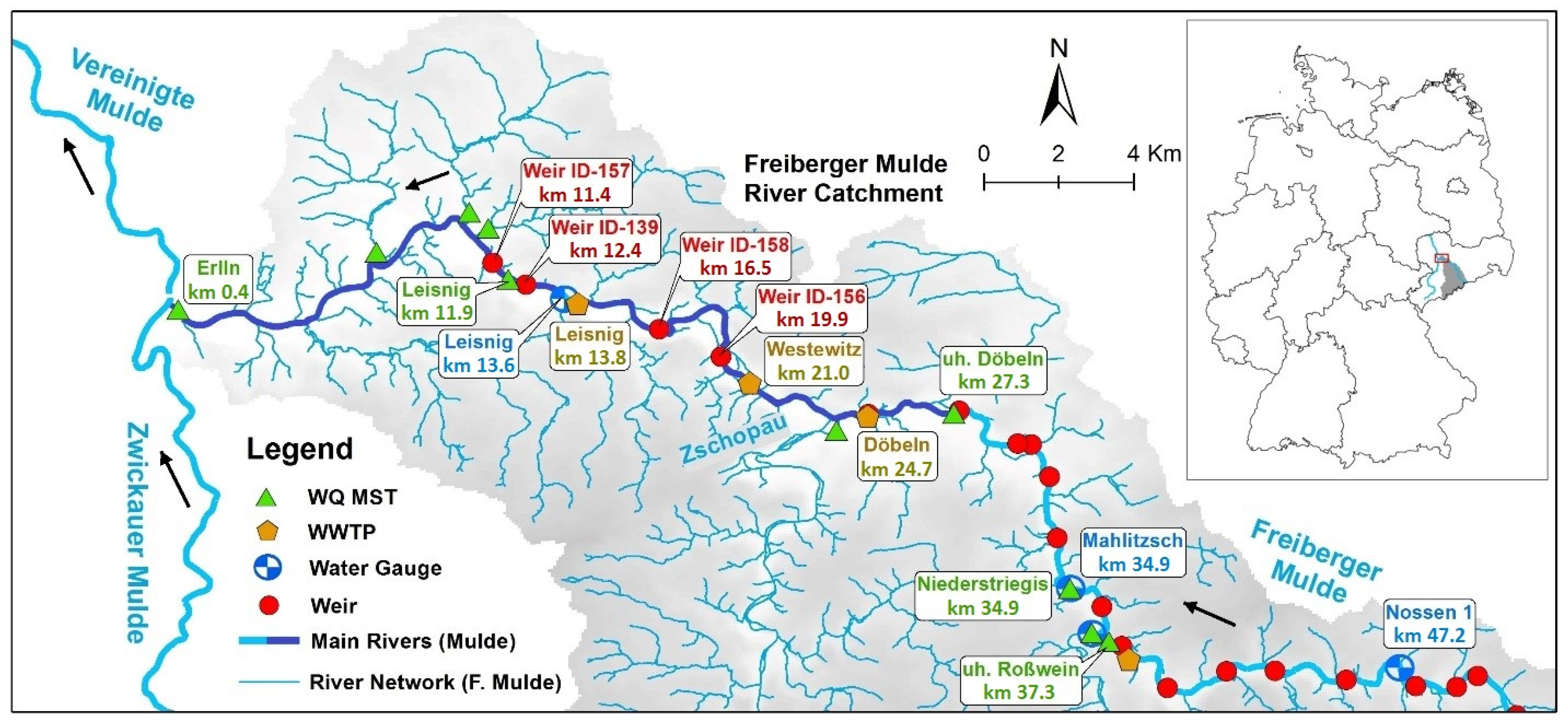
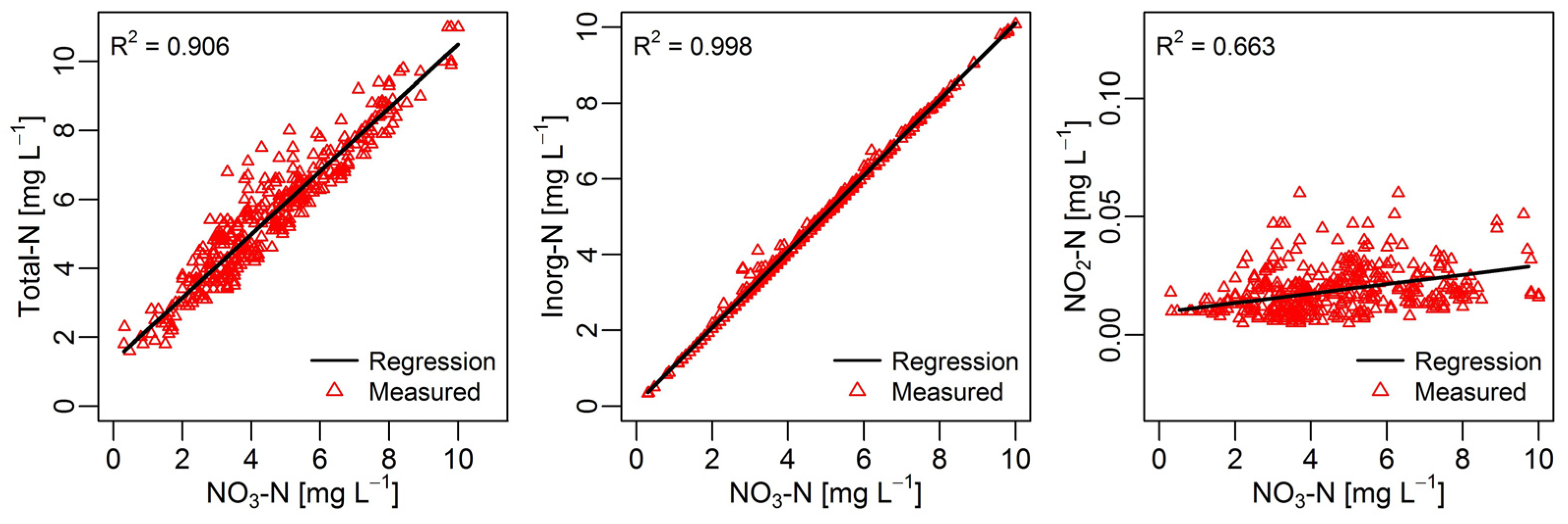
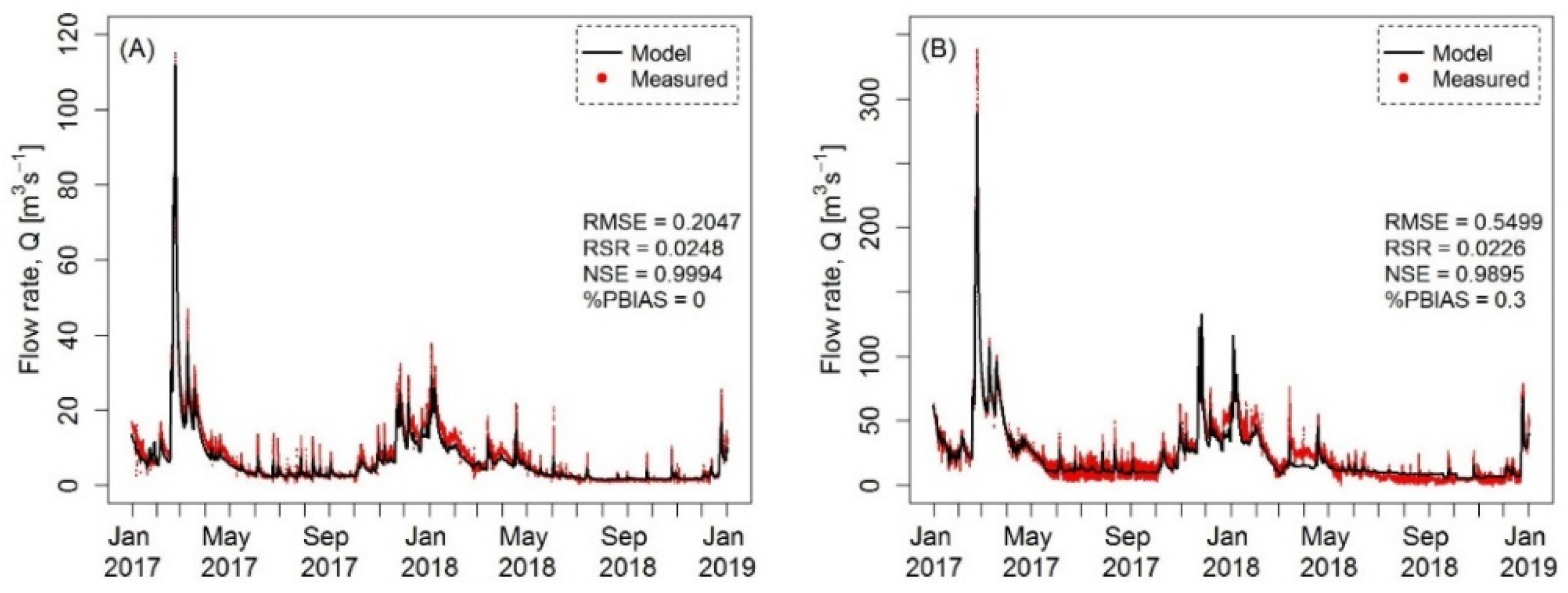
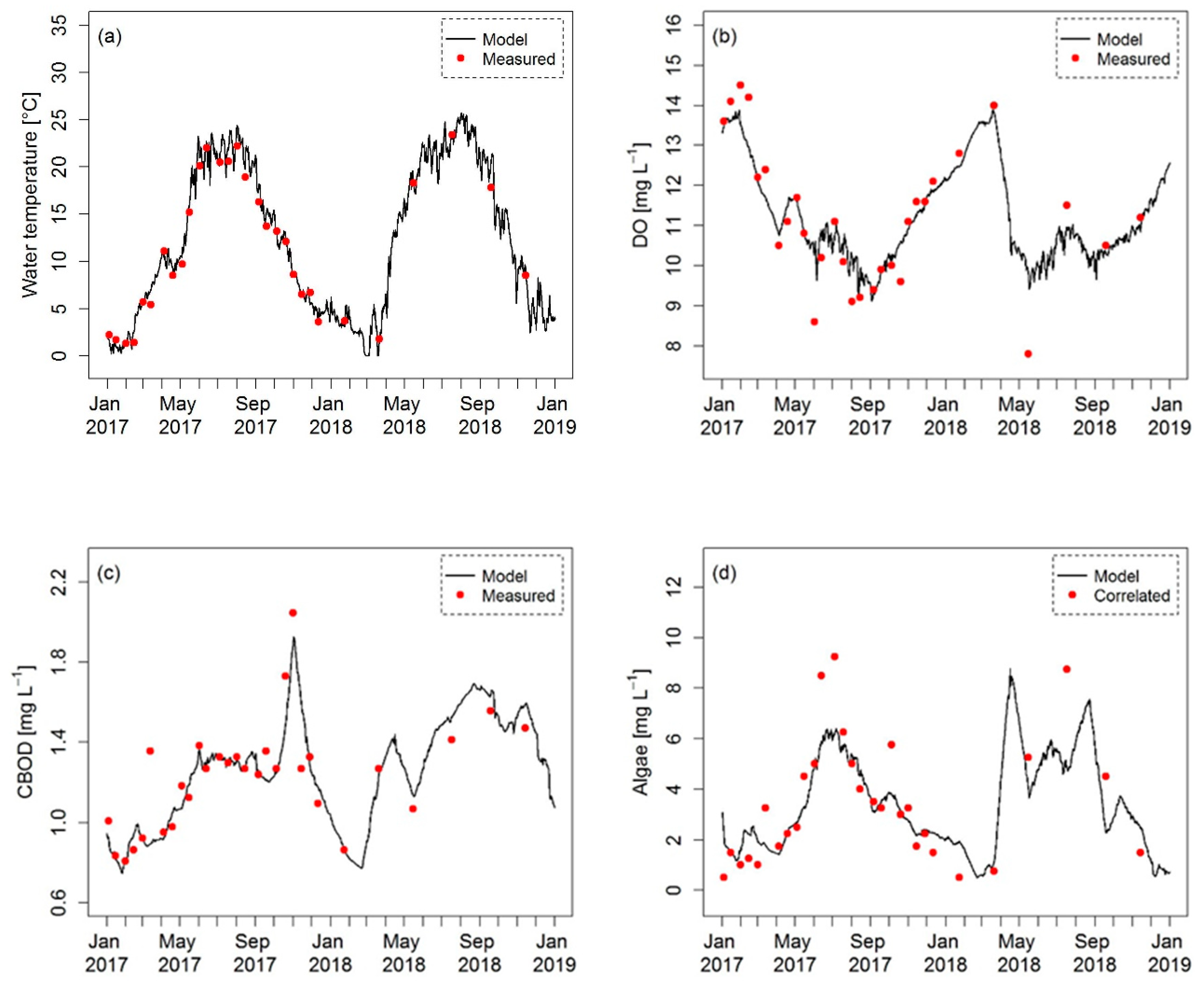
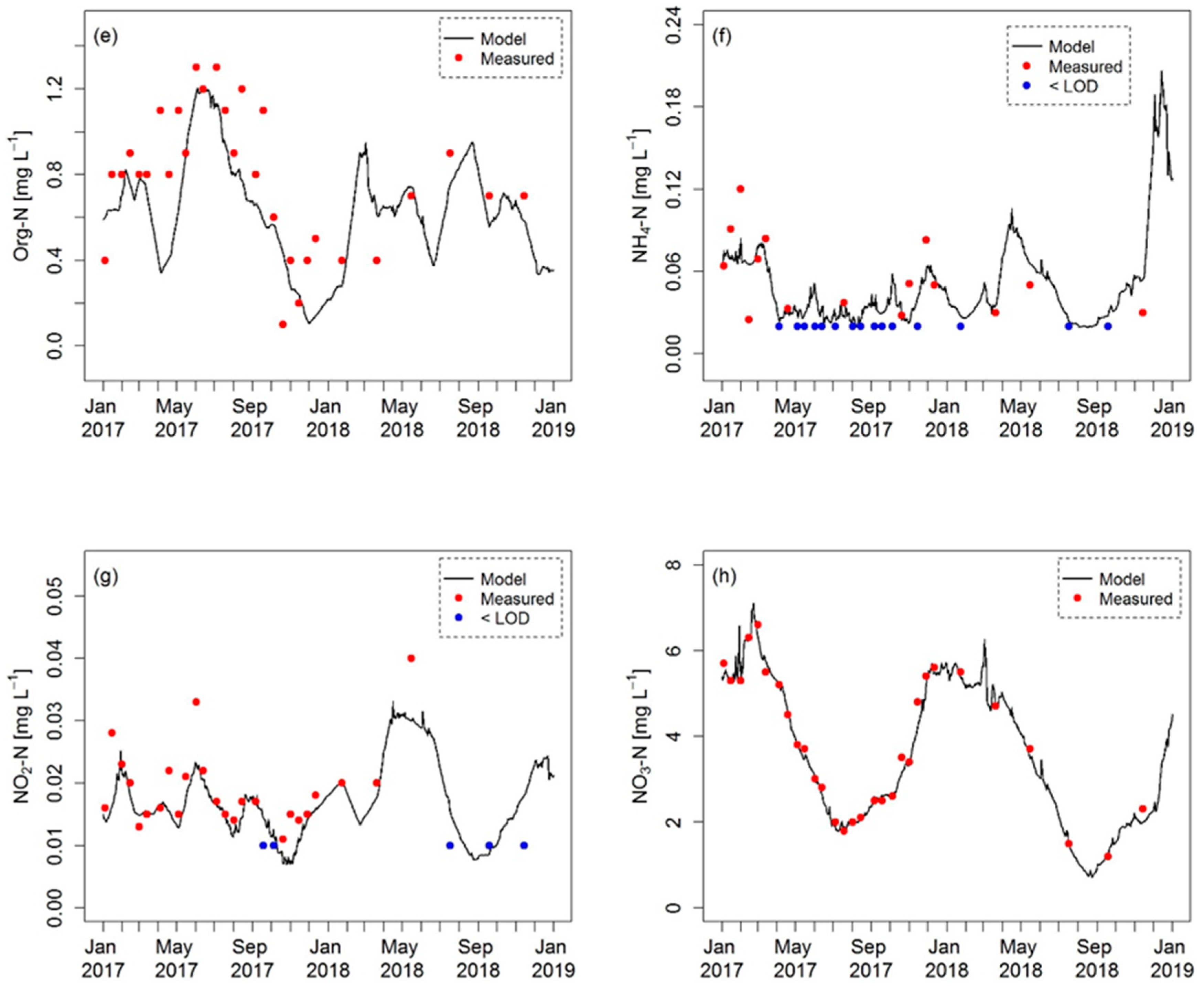
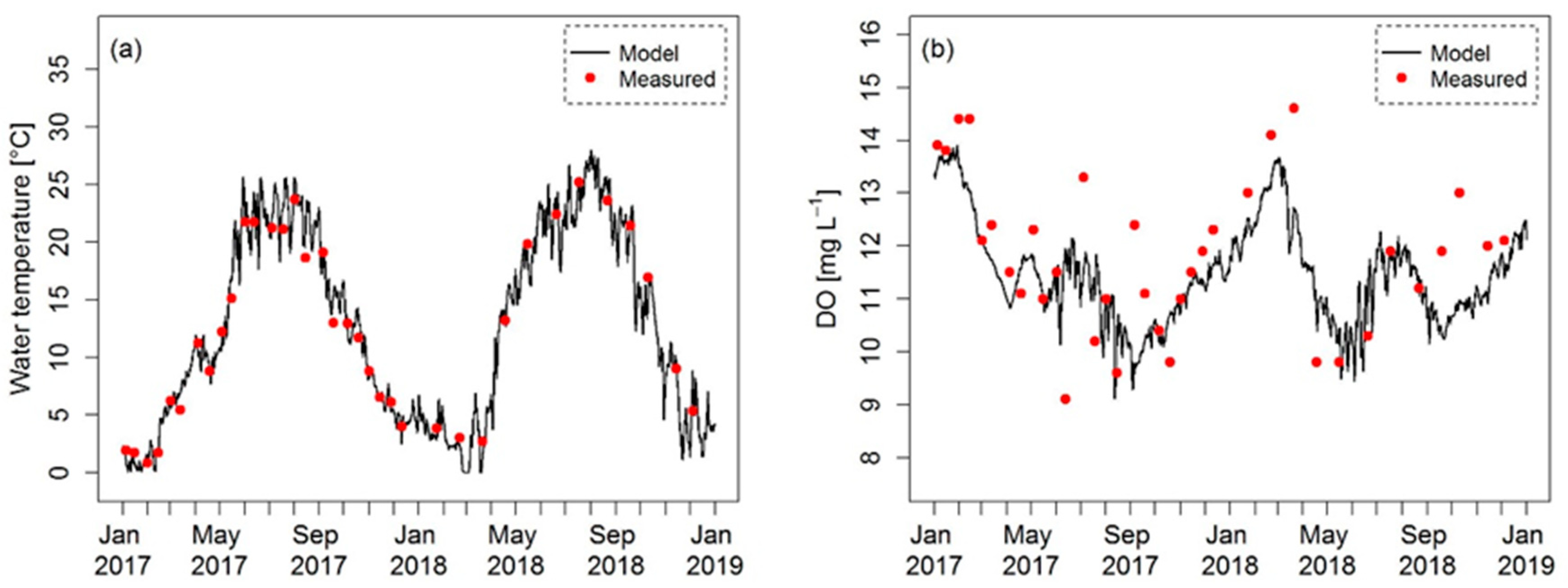
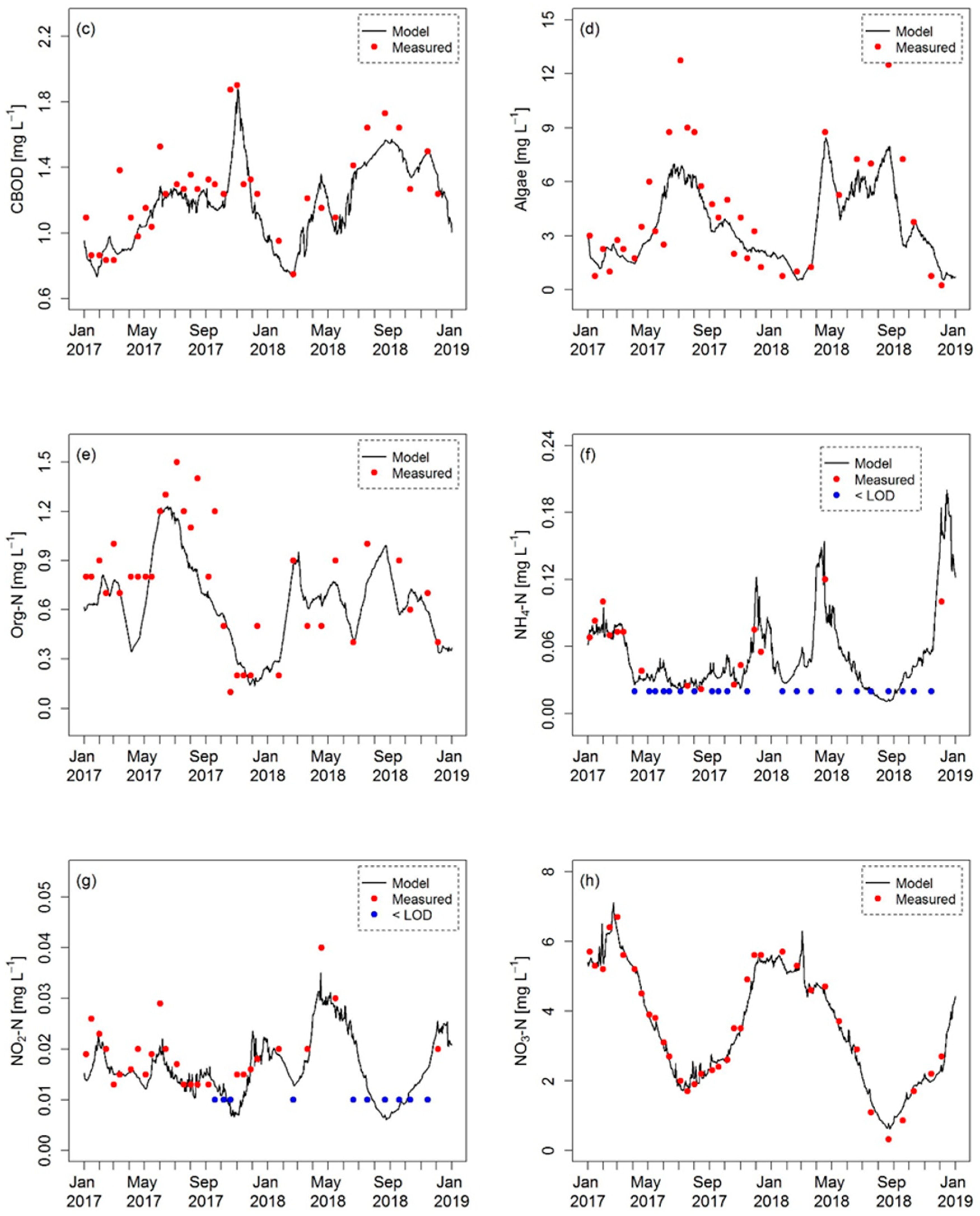
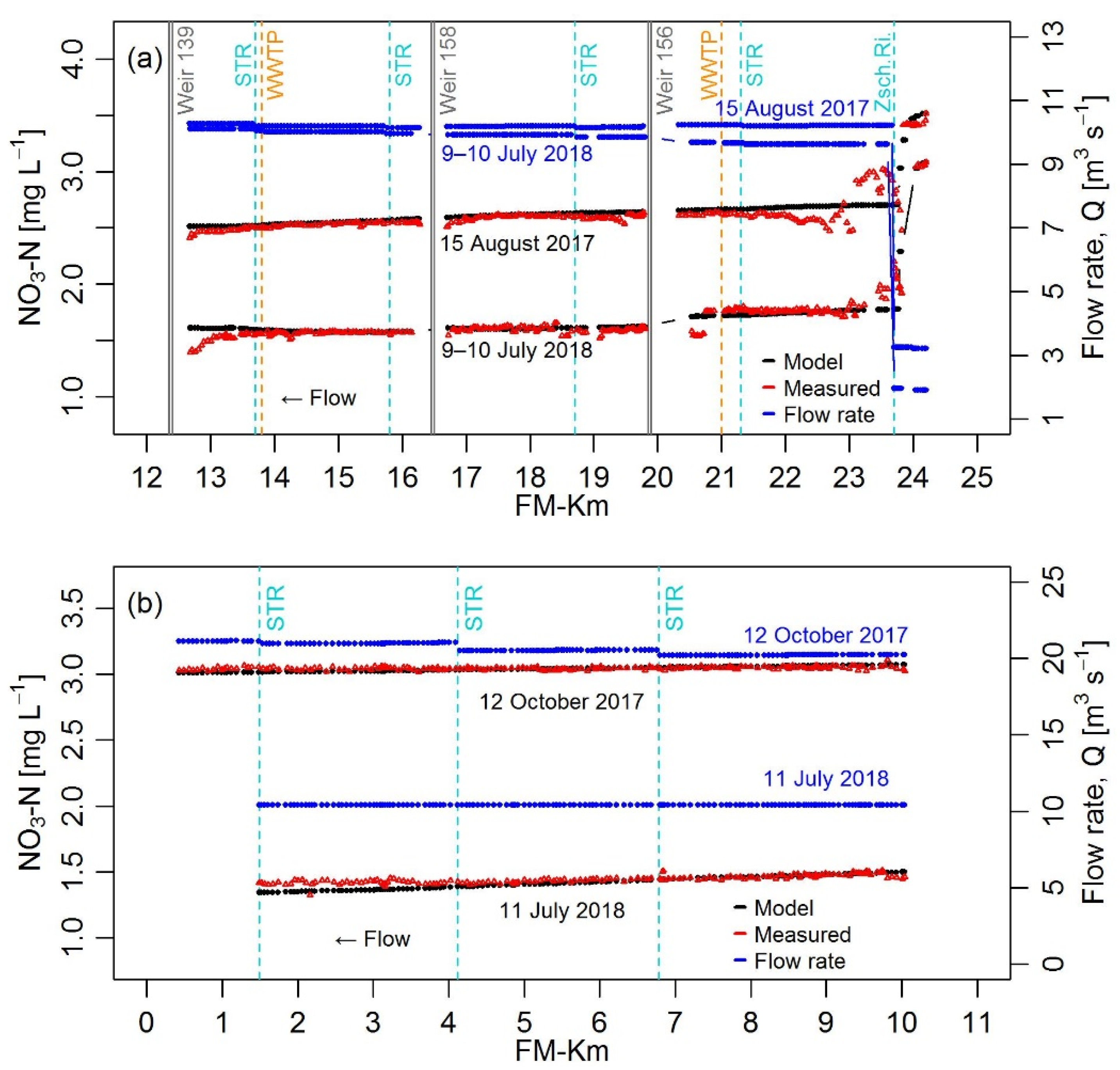
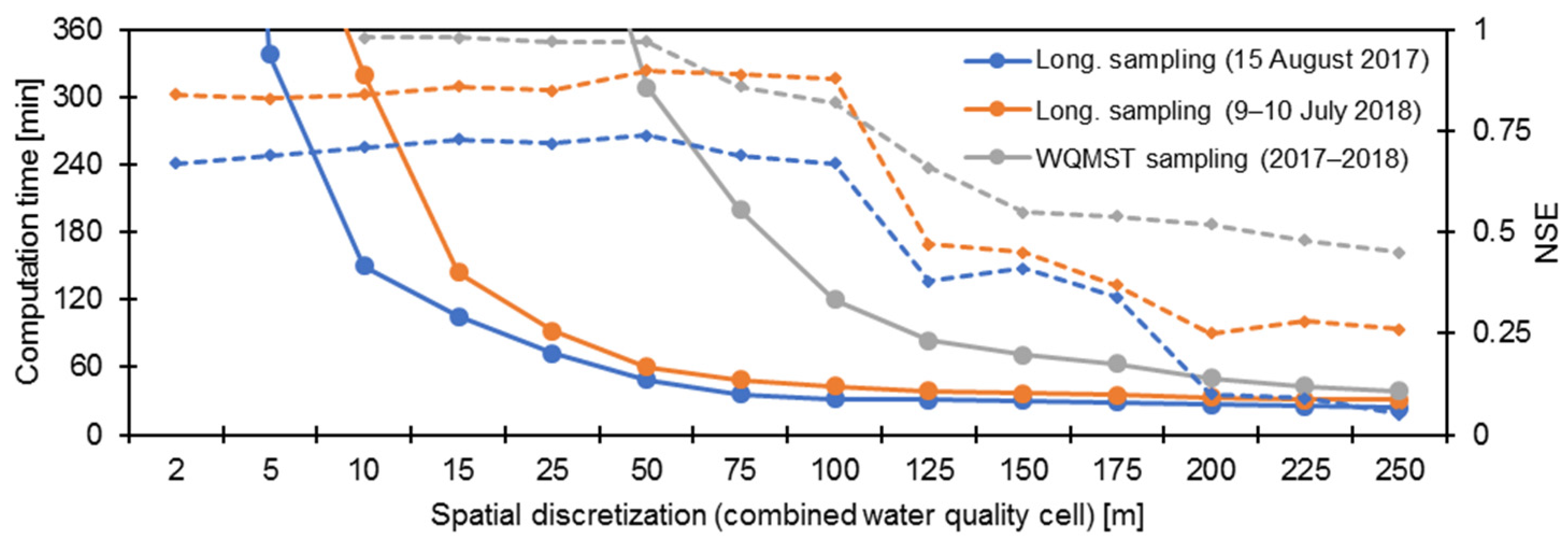
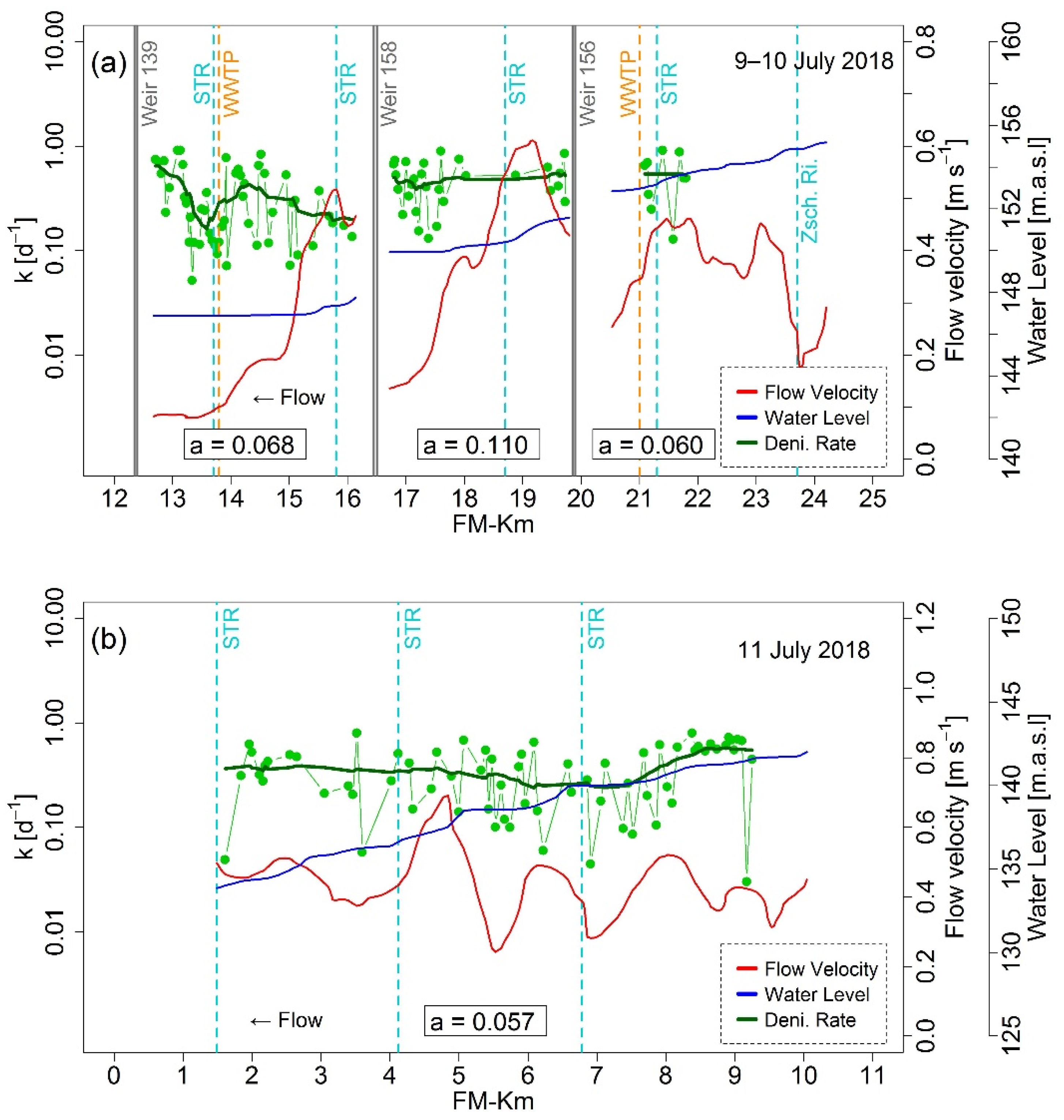
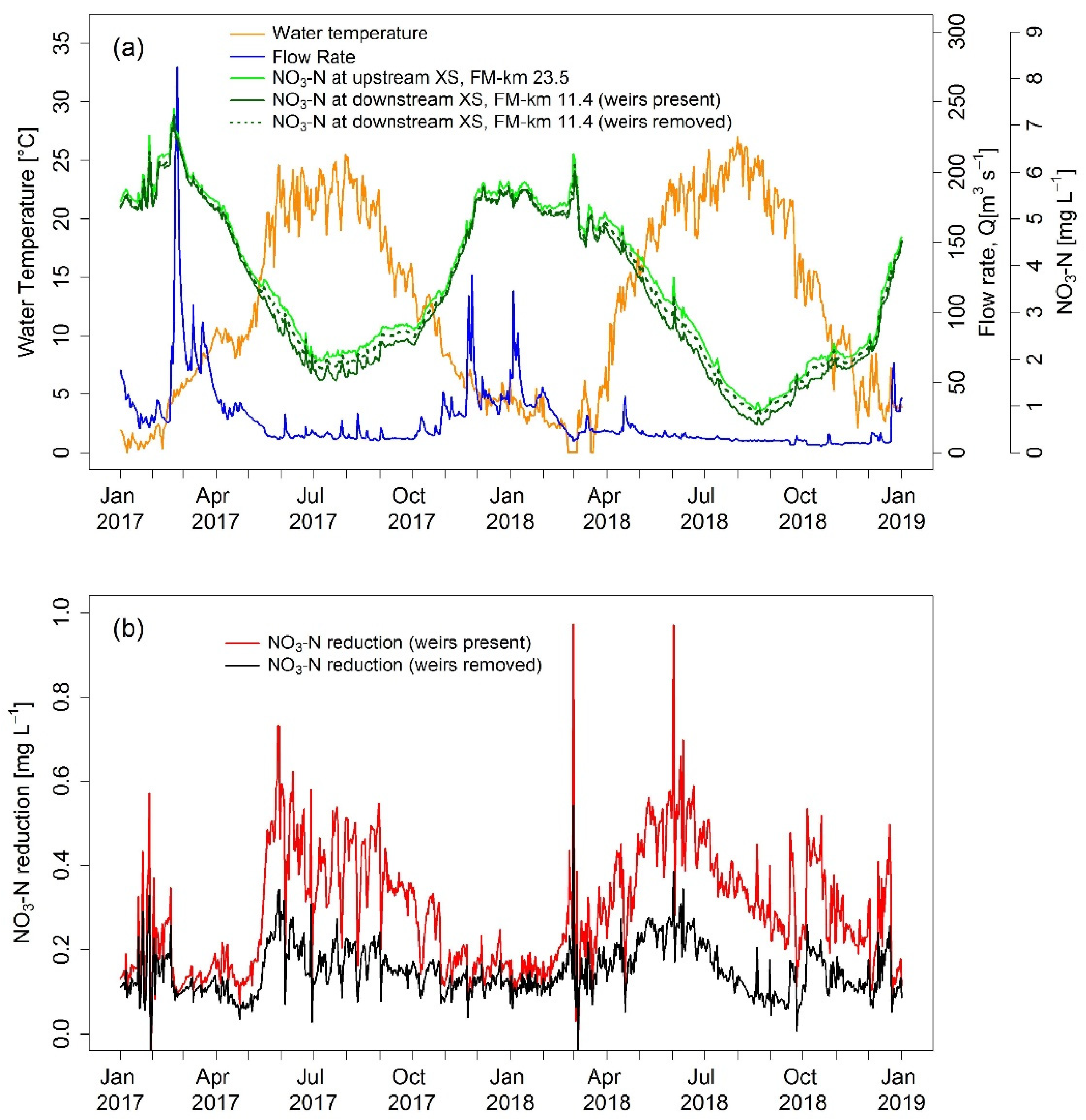
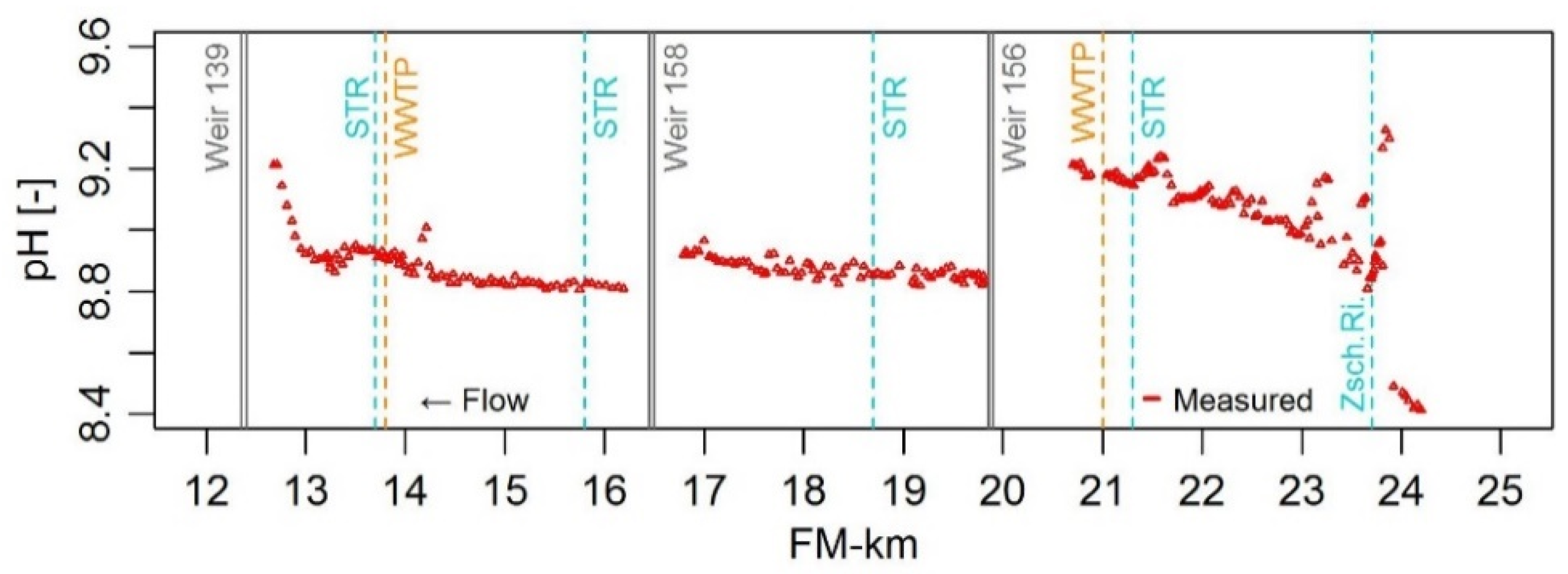
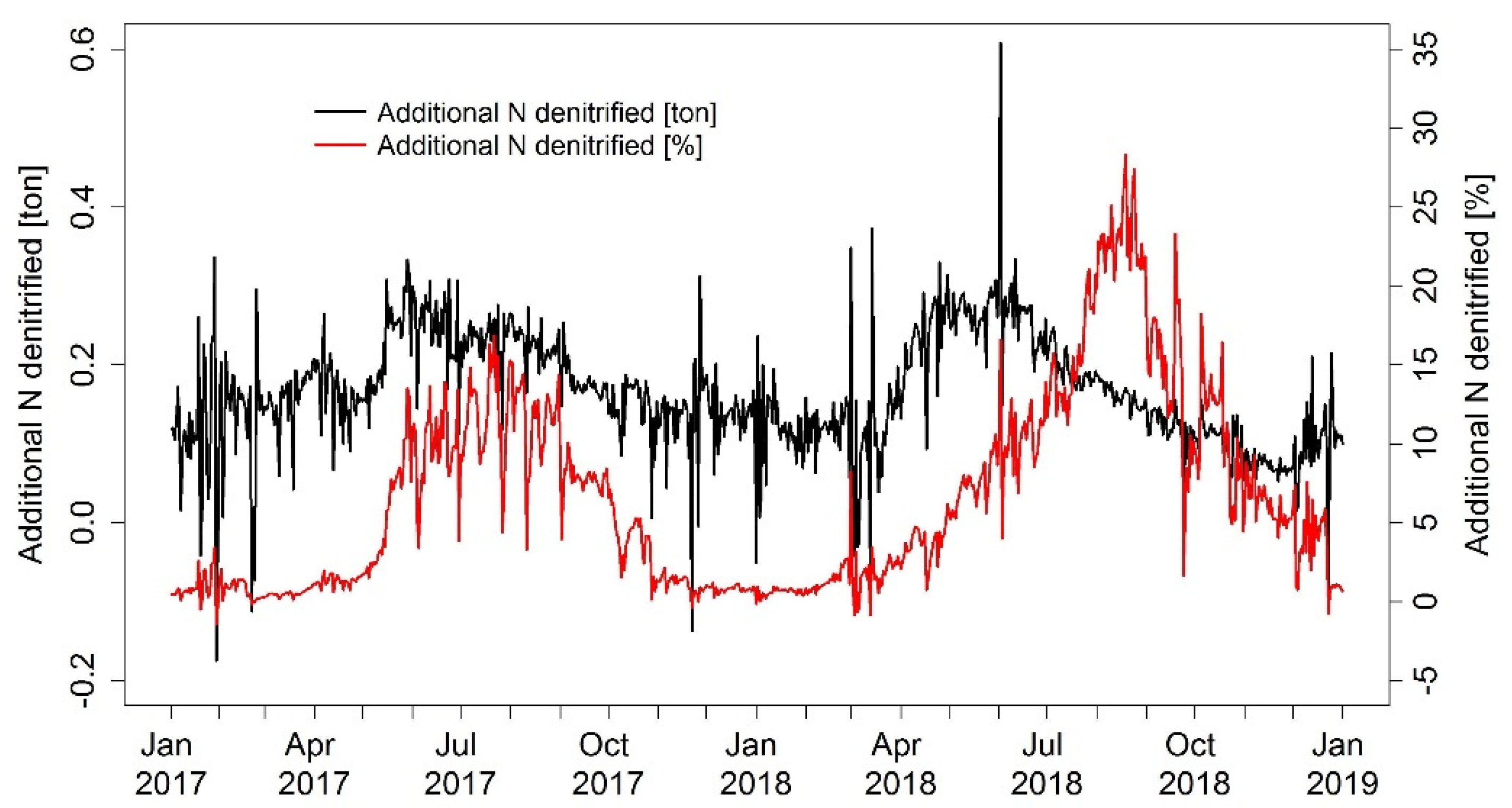
| Turnover Rate | WQMST Leisnig (FM-km 11.9, Weirs Present) | WQMST Erlln (FM-km 0.4, without Weirs) |
|---|---|---|
| Sediment oxygen demand (d−1) | 0.20 | 0.20 |
| Atmospheric reaeration (d−1) | 0.50 | 0.50 |
| Algal photosynthesis (mg O mg Algae−1) | 1.80 | 1.80 |
| Algal respiration (mg O mg Algae−1) | 1.70 | 1.70 |
| CBOD oxidation (d−1) | 0.02 | 0.02 |
| CBOD settling (d−1) | 0.00 | 0.00 |
| Nitrification inhibition Factor (KNR) (mg L−1) | 0.65 | 0.65 |
| Maximum algal growth rate (d−1) | 1.00 | 1.00 |
| Algal settling rate (m d−1) | 0.10 | 0.10 |
| Algae → Org-N (mg N mg Algae−1) | 0.09 | 0.09 |
| Org-N settling (d−1) | 0.001 | 0.001 |
| Org-N → NH4-N (d−1) | 0.003 | 0.010 |
| NH4-N → NO2-N (d−1) | 0.29 | 0.15 |
| NO2-N → NO3-N (d−1) | 0.71 | 0.55 |
| Parameter | WQMST Leisnig (FM-km 11.9) | WQMST Erlln (FM-km 0.4) | ||||||
|---|---|---|---|---|---|---|---|---|
| RMSE | RSR | NSE | PBIAS % | RMSE | RSR | NSE | PBIAS % | |
| Water temperature | 0.967 | 0.132 | 0.982 | −0.4 | 1.482 | 0.189 | 0.963 | 2.5 |
| DO | 0.643 | 0.371 | 0.858 | −1.4 | 1.012 | 0.686 | 0.515 | −3.0 |
| CBOD | 0.129 | 0.475 | 0.766 | −1.0 | 0.166 | 0.593 | 0.638 | −6.5 |
| Algae | 1.490 | 0.609 | 0.617 | −14.2 | 1.985 | 0.600 | 0.630 | −19.7 |
| Org-N | 0.261 | 0.810 | 0.321 | −18.3 | 0.249 | 0.664 | 0.547 | −16.4 |
| NH4-N 1 | 0.020 | 0.718 | 0.448 | −3.6 | 0.019 | 0.646 | 0.553 | 3.6 |
| NO2-N 1 | 0.005 | 0.695 | 0.497 | −15.1 | 0.005 | 0.722 | 0.458 | −13.2 |
| NO3-N | 0.179 | 0.113 | 0.987 | −1.7 | 0.270 | 0.158 | 0.974 | −2.3 |
| Turnover Rate | Boat-Based Data (FM River Section with Weirs Present) | Boat-Based Data (FM River Section without Weirs) |
|---|---|---|
| Algae → Org-N (mg-N mg-Algae−1) | 0.09 | 0.09 |
| Org-N Settling (d−1) | 0.005 | 0.005 |
| Org-N → NH4-N (d−1) | 0.003 | 0.015 |
| NH4-N → NO2-N (d−1) | 0.17 | 0.13 |
| NO2-N → NO3-N (d−1) | 0.78 | 0.52 |
| Parameter | FM River Section with Weirs | FM River Section without Weirs 1 | |||
|---|---|---|---|---|---|
| RMSE | PBIAS % | NSE | RMSE | PBIAS % | |
| Algae | (0.261, 0.574) | (−1.0, 2.4) | (0.60, 0.77) | (0.135, 0.722) | (1.2, 1.7) |
| Org-N | (0.010, 0.013) | (0.1, 0.7) | (0.61, 0.71) | (0.001, 0.002) | (0.1, 0.1) |
| NH4-N | (0.001, 0.001) | (−0.2, 0.1) | (0.52, 0.80) | (0.001, 0.001) | (0.1, 0.2) |
| NO2-N | (0.001, 0.001) | (0.1, 0.3) | (0.71, 0.78) | (0.001, 0.002) | (−0.9, 0.1) |
| NO3-N | (0.086, 0.092) | (−0.3, 0.3) | (0.67, 0.89) | (0.018, 0.380) | (−0.2, −1.6) |
Publisher’s Note: MDPI stays neutral with regard to jurisdictional claims in published maps and institutional affiliations. |
© 2022 by the authors. Licensee MDPI, Basel, Switzerland. This article is an open access article distributed under the terms and conditions of the Creative Commons Attribution (CC BY) license (https://creativecommons.org/licenses/by/4.0/).
Share and Cite
Teran-Velasquez, G.; Helm, B.; Krebs, P. Longitudinal River Monitoring and Modelling Substantiate the Impact of Weirs on Nitrogen Dynamics. Water 2022, 14, 189. https://doi.org/10.3390/w14020189
Teran-Velasquez G, Helm B, Krebs P. Longitudinal River Monitoring and Modelling Substantiate the Impact of Weirs on Nitrogen Dynamics. Water. 2022; 14(2):189. https://doi.org/10.3390/w14020189
Chicago/Turabian StyleTeran-Velasquez, Geovanni, Björn Helm, and Peter Krebs. 2022. "Longitudinal River Monitoring and Modelling Substantiate the Impact of Weirs on Nitrogen Dynamics" Water 14, no. 2: 189. https://doi.org/10.3390/w14020189
APA StyleTeran-Velasquez, G., Helm, B., & Krebs, P. (2022). Longitudinal River Monitoring and Modelling Substantiate the Impact of Weirs on Nitrogen Dynamics. Water, 14(2), 189. https://doi.org/10.3390/w14020189







